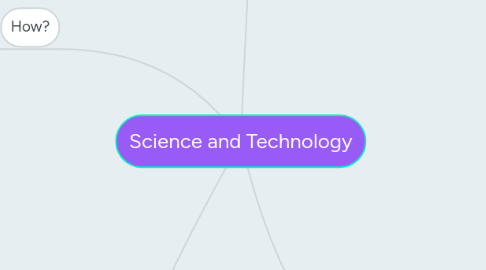
1. What?
1.1. Technology is slowly furthering science
1.1.1. Medical Field
1.1.1.1. For example, an A*STAR researcher is researching to find a better more efficient way of creating vaccines.
1.1.1.1.1. By injecting human stem cells with the particular cancer/tumor cells and then adding antigens, a substance that induces an immune response in the human body.
1.1.2. Research
1.1.2.1. By using data collected over the past few years to form simulations
1.1.2.1.1. Example: A simulation of the Singapore transport system. To predict what will happen when a train on a particular line has broken down.
1.1.2.1.2. Simulations are more effective as Researches can achieve results without conducting an on-field experiment.
1.1.3. Different scopes used
1.1.3.1. Electron Microscope
2. How?
2.1. Positive Effects
2.1.1. Research
2.1.1.1. student might find it difficult to compile the necessary research for an essay or research paper. With technology information can be found with a tap of a button
2.1.2. Communication
2.1.2.1. we are able to reach distant places within hours which took years of time to reach in olden days. Instead of sending letters, emails can be send within seconds
2.2. Negative Effects
2.2.1. Health
2.2.1.1. children are getting addicted to online games causing their physical activities and exercises rate to decrease
2.2.2. Neglection
2.2.2.1. We may too concentrated with our "technology" that we neglect our families or friends
2.2.3. excessive relying
2.2.3.1. as we rely more on technology, it would prevent us from using the brain and reduce our mental work
2.2.3.1.1. Technology is a useful servant but a dangerous master. -Christian Lous Lange
3. Who? (People Affected)
3.1. Young
3.1.1. Easier Learning
3.1.1.1. Internet lets youth connect into a lot of information required to do certain tasks
3.1.1.2. The real power of interactive communications is people as the ultimate source of knowledge. It is not the computers, the physical mass of wires, the complex of networks or the vast databases of information. Rather, it is people and their knowledge, relationships, insights, and spirit freely passed from one to another that engender the “magic” of this interconnected world that the Internet is making possible.
3.2. Elderly
3.2.1. Automated Wheelchairs
3.3. Businesses
3.3.1. Consolidating of data
3.3.2. Presentation of statistics
3.3.3. More organised
3.4. Able to communicate with distant relatives easier
3.5. School
3.5.1. Teachers
3.5.2. Students
3.5.3. Education
4. Where? (In different countries)
4.1. Singapore
4.1.1. Transport Systems
4.1.1.1. Unmanned MRTs
4.1.1.1.1. Such as the ones in Circle Line
4.1.1.2. Tracking of faulty appliances
4.1.1.2.1. Example: The current signal receiver problem on the Circle Line
4.1.2. Amusement parks
4.1.2.1. Universal Studios
4.1.2.1.1. Example: Science and Technology have contributed into the construction of many attractions, such as the roller coasters Cylon, Human, and The Revenge of the Mummy ride.
4.1.2.1.2. 4D short films such as the Shrek Adventure
4.1.2.1.3. Science and Technology have contributed much into the making of Transformers:The Ride
4.2. Japan
4.2.1. Consumer Electronics
4.2.1.1. Smartphones
4.2.1.1.1. Lighter, flatter and more carry-friendly phones have been developed using science and technology
4.2.1.2. Televisions
4.2.1.2.1. Current televisions are more vibrant in colour
4.2.1.2.2. Flatscreen TVs
4.2.1.3. Computers
4.2.1.3.1. Computers in present day are faster, effective, smaller, thinner and lighter as compared to computers 10 years ago
4.2.2. Robotics
4.2.2.1. These technologies deal with automated machines (robots for short) that can take the place of humans in dangerous environments or manufacturing processes, or resemble humans in appearance, behaviour, and or cognition. Many of today's robots are inspired by nature, contributing to the field of bio-inspired robotics.
4.2.2.2. Many robots are built to do jobs that are hazardous to people such as defusing bombs, finding survivors in unstable ruins, and exploring mines and shipwrecks.
4.2.3. Manufacturing of Nuclear Power
4.2.3.1. Since 1973, Japan has been looking to become less dependent on imported fuel and start to depend on nuclear energy. In 2008, after the opening of 7 brand new nuclear reactors in Japan (3 on Honshū, and 1 each on Hokkaidō, Kyūshū, Shikoku, and Tanegashima) Japan became the third largest nuclear power user in the world with 55 nuclear reactors. These provide 34.5% of Japan's electricity.
4.2.3.2. Following an earthquake, tsunami, and the failure of cooling systems at the Fukushima I Nuclear Power Plant on March 11, 2011, a nuclear emergency was declared. 140,000 residents within 20 km of the plant were evacuated. See Radiation effects from Fukushima Daiichi nuclear disaster 900
4.3. UK
4.3.1. Major theories from people like Isaac Newton and Charles Darwin contributed to many current theories on Earth today
4.3.2. The UK plays a leading part in the aerospace industry, with companies including Rolls-Royce playing a leading role in the aero-engine market; BAE Systems acting as Britain's largest and the Pentagon's sixth largest defence supplier, and large companies including GKN acting as major suppliers to the Airbus project. Two British-based companies, GlaxoSmithKline and AstraZeneca, ranked in the top five pharmaceutical companies in the world by sales in 2009 and UK companies have discovered and developed more leading medicines than any other country apart from the US
